2.2 Retain Publisher and Viewer
Retain comes with the ability to export selected messages to a local archive for searching and viewing or to fulfill the need of a mobile archive for legal compliance. This can be extremely useful for larger systems or systems which have a high load, and where the need for review or legal compliance is being exercised, but access to the entire Retain archive is not necessary. Instead of allowing or facilitating constant access to the entire Retain Server, the Publisher can export and index groups of messages to a local archive, and the Viewer can search, view, and forward messages from the local archive.
The process is performed in two parts: the Publisher and the Viewer. The publisher, using an existing account with the Publish Messages right, connects to the Retain Server and exports the messages complying with the search request, and creates a local database archive on the host machine. The viewer accesses the local archive and allows browsing, searching, and message exportation from the local archive.
2.2.1 System Requirements:
-
Windows 7x, 8x, 10x (32-bit or 64-bit).
-
.Net 4.5 SP1.
-
PST migration requires Outlook to be installed. (32 and 64-bit systems are supported.)
-
Network connection to Retain Server.
-
Retain user with rights to Publish Messages (see
Users
in Retain 4.9.2: Configuration and Administration).
NOTE:Due to file access, the publisher cannot publish archives to a network drive.
The Viewer can be run or be installed as stand-alone client wherever a published archive exists, but it is recommended to install the Viewer when you install the Publisher. While the Viewer and Publisher can be installed and run separately, the Viewer must have direct access to the published archive. Do not place the published archive on a network share. Accessing the published database from a remote machine may cause instability and is insecure. For this reason, it is best to use the Viewer local to the published archive.
Download the tools from the Retain site
Run the installers on the desired machine.
The Retain Publisher and Viewer are found on the tools page. To access the tools page, select the 'tools' link from the top right of the Retain Server administration page.

2.2.2 Installation
The Retain Publisher installation is very similar to the Viewer installation. Basic questions are asked, and the installer checks for .NET 4.5 SP1 before copying or installing any files. Click ‘Next’ to continue.
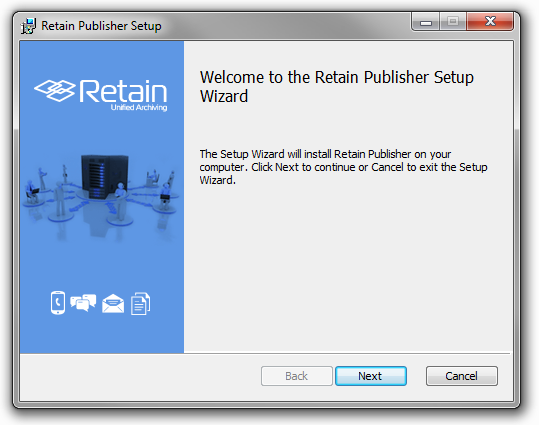
Read and accept the license agreement. Select ‘Next’ to continue.
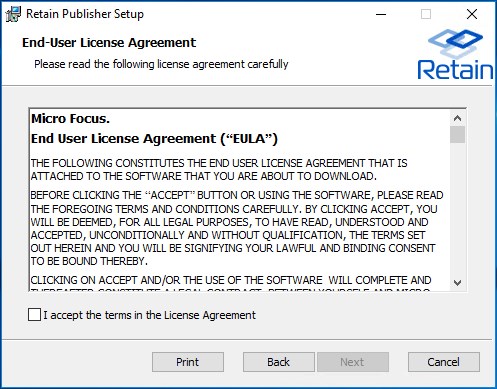
The installer checks for any programs that need to be closed for installation. Close any applications specified and click ‘Next’. Otherwise you will need to choose which users to install the software to.
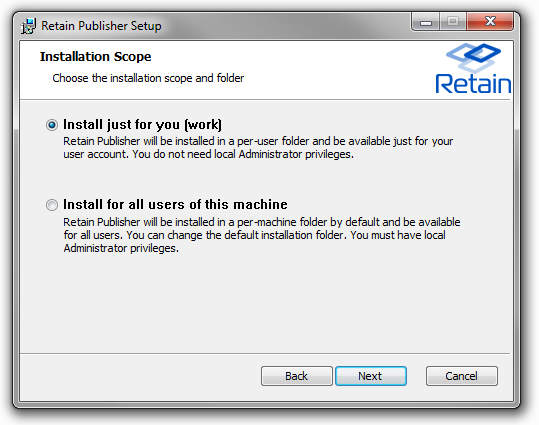
Select the scope of the install
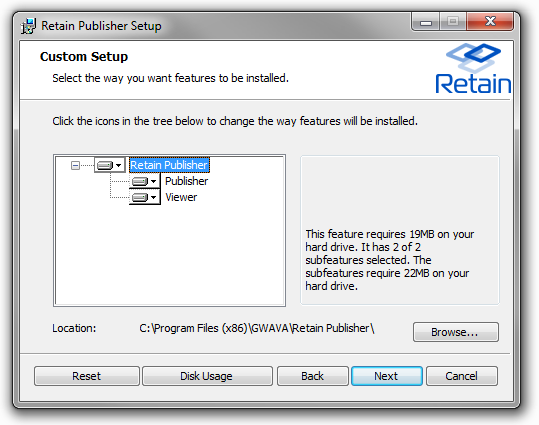
Select which components to install.
The Publisher installation provides the option to install the viewer alongside the publisher. If the viewer has already been installed, this is not necessary. It is recommended to have both the viewer on the same machine as the publisher. To only install the viewer, unselect the publisher. Select the desired setting and click ‘Next’ to continue.
Select the install location. The default is shown. If the default location does not work for the system, browse to, or specify the desired install location.
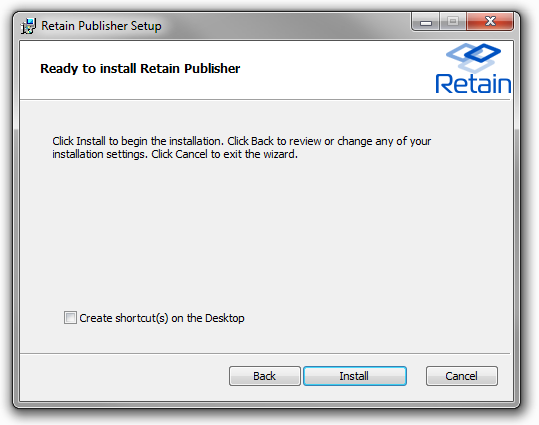
Select whether to create shortcuts or not. Default is to not create shortcuts. Select the check box to create shortcuts on the Desktop.
Click ‘Install’ to begin installation.
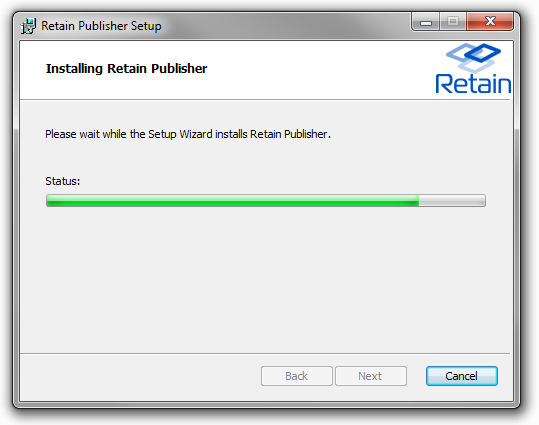
Wait for installation to complete.
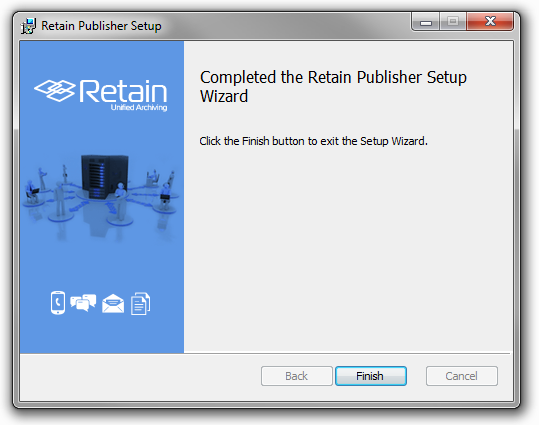
After install has completed, select ‘Finish’.
2.2.3 Retain Publisher
The Retain Publisher must be run to create the local archive for the Viewer to connect to. The Publisher does not display messages, it just accesses and exports messages into a portable message archive.
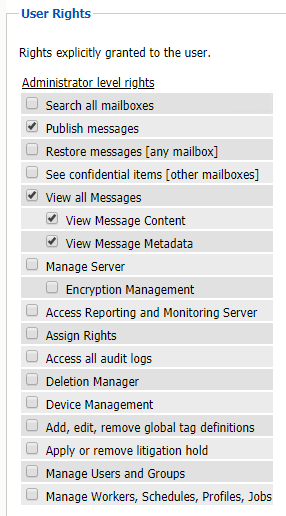
The Publisher must be used in conjunction with a user that has administrator rights to publish messages. Because the Publisher connects over the network, it requires an open network connection to the Retain Server.
The Administrator account for Retain automatically has the publish messages right, and can be used here, though it is highly recommended to create and use an auditor account with the mail export right and access to the desired mailboxes or post offices required.
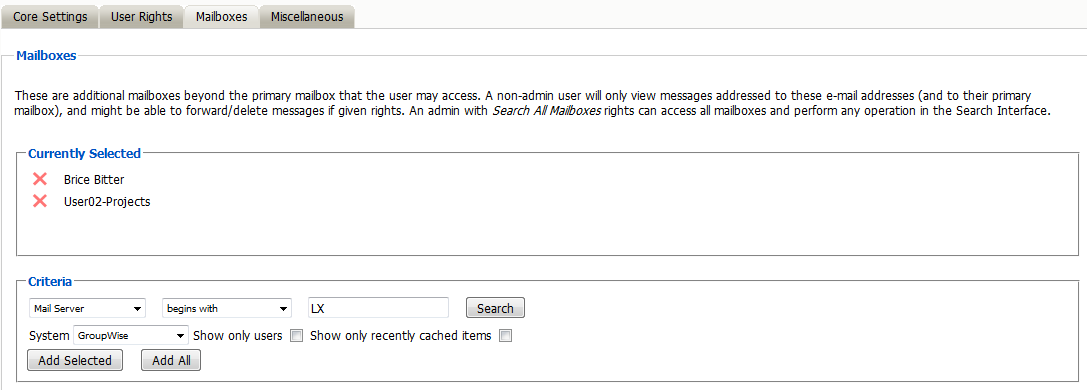
Start Retain Publisher by opening the program Publisher.exe.
2.2.4 Retain Server Information Page
Input the Retain Server’s DNS or IP Address and the login for the account with message export rights and rights to the desired mailboxes. Unless the login account has the administrator level right to ‘search all mailboxes’, only the mailboxes granted to the auditor account will be accessible. Granting rights to mailboxes other than the active user’s own mailbox are specified in the user rights section, under the ‘mailboxes’ tab.
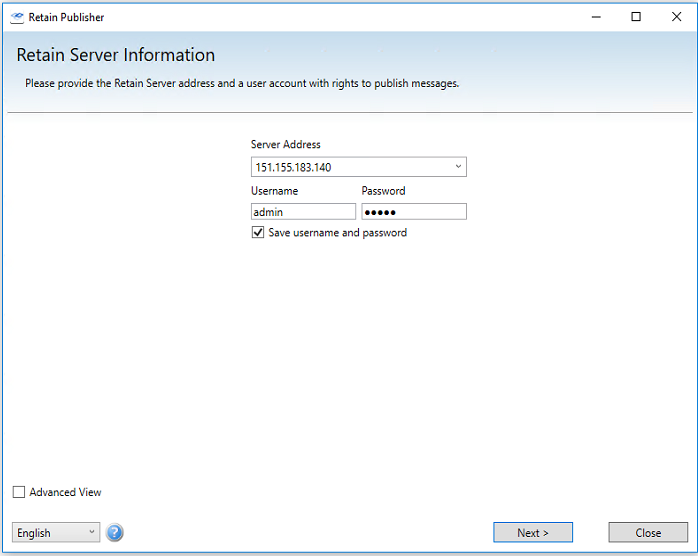
The advanced view provides a protocol and port options.
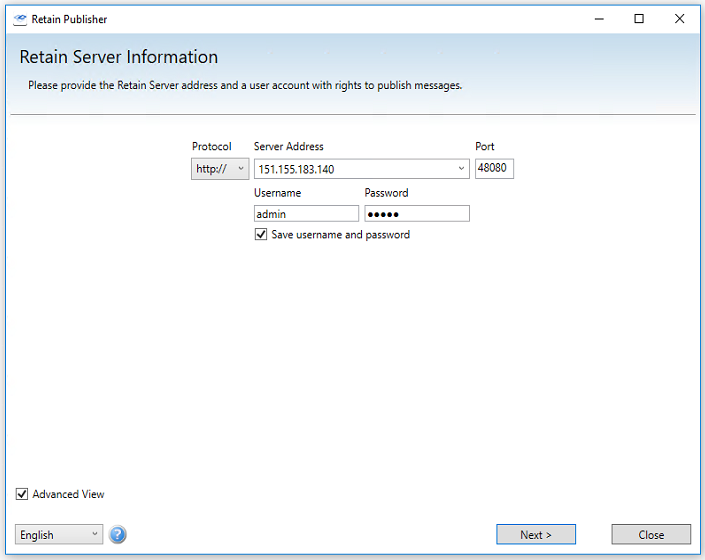
Select ‘Next’ to login to the Retain Server.
Publishing Location Page
The Publisher then asks for the desired location for the exported archive messages.
The messages extracted from the Retain Server will be saved in a database at this location. Select an existing location or select the green plus button and then browse to, or create a new folder for the published archive destination. If a destination is selected which already contains an existing archive, a warning of overwriting an existing archive will be displayed.
You must select, or create and select, a location for the messages to be exported to before you may proceed to the next screen.
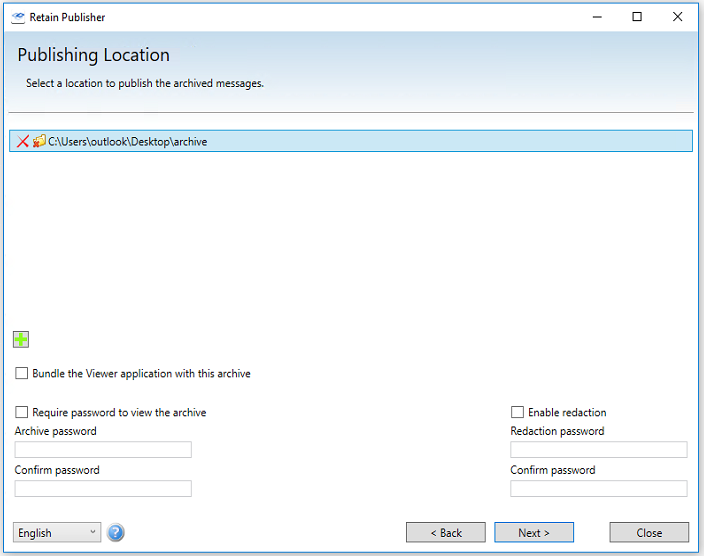
The options to password protect and use Redaction, both require passwords. To use them, select the checkbox and specify a password. The passwords can be different and both options may be present on the same archive.
When the ‘Bundle the Viewer application with this archive’ option is selected, the Viewer installation file is copied into the archive as well, preparing it to be completely mobile; the entire destination folder can then be copied or sent to any system with all that is required to read and search the archive. If the archive is to be distributed on a burned DVD or CD, further redaction will not function from the disk. All redaction comments should either be made before the archive is burned to a disk, or the archive should be copied from the disk to a local location where changes can be saved. When writing the archive to a read-only medium, it is always prudent to finalize the compilation.
Making the archive mobile can be very useful in situations where direct access to the Retain archive, such as during legal discovery, when email information is required to be surrendered for a user or group of users, an archive can be created and provided without disrupting current Retain operation. Click ‘Next’ to continue.
Address Book Page
Select the Post office and/or users to dredge.
Search for users by their display name.
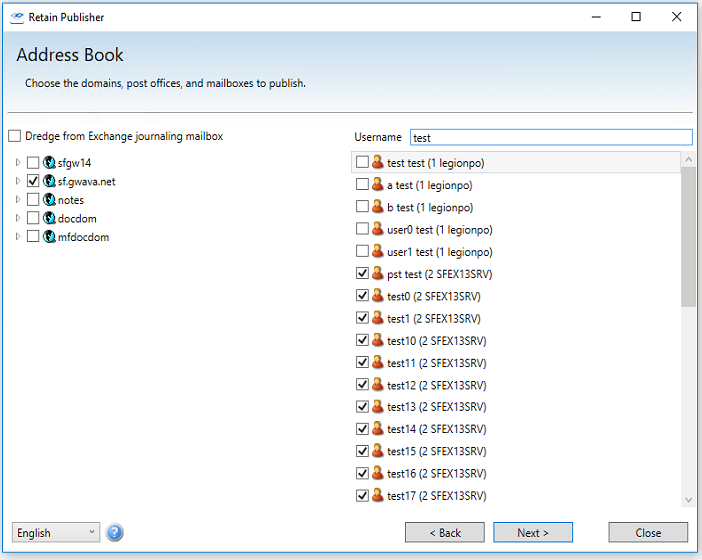
Query Form Page
Select or create a query to filter the scope of the export job. There are three tabs but you only need to use the one you need to build the query. You can use a query saved in the Retain Web console, a simple search or an advanced search.
If you don’t want to perform a query, press the “Skip this step” button.
Queries Tab
A query saved Searching in Retain’s Archives on the Retain Server can be loaded at this point.
Queries can be saved under the Search and Advanced Search tabs in the Search Messages Web interface. Publisher requires you to log in to the same account as the one used in the web interface to access the saved query.
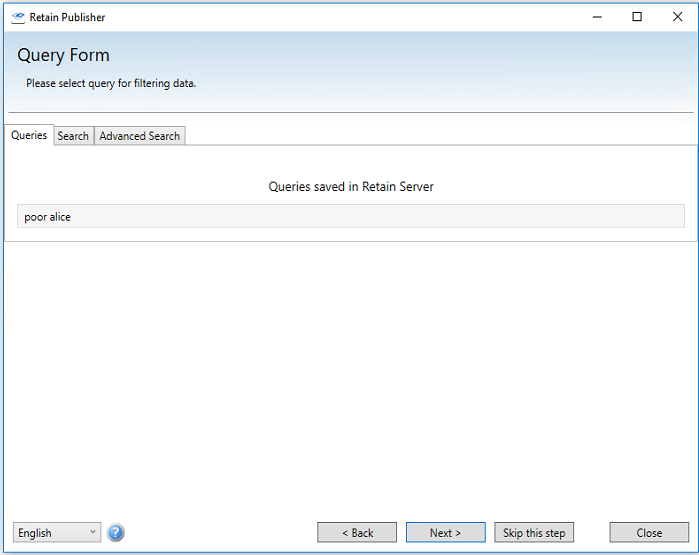
Search Tab
The Search tab allows you to create a simple search query within Publisher.
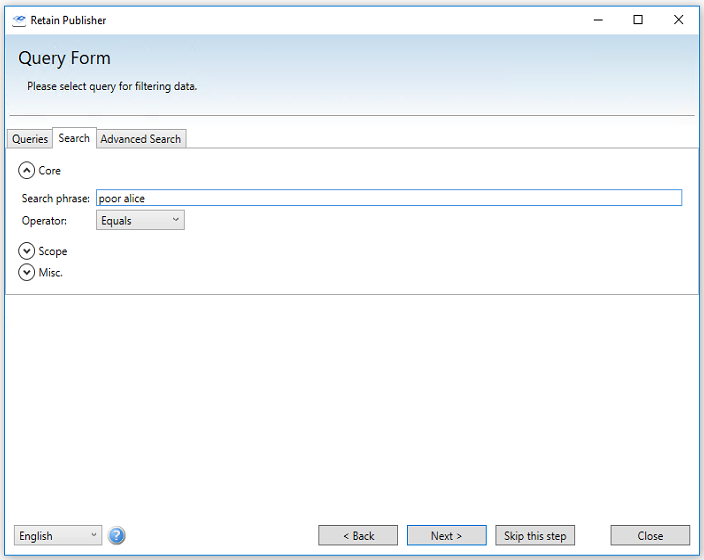
Advanced Search Tab
The Advanced Search Tab allows you to create a complex search query within Publisher.
The Publisher may restrict what mail or items are published into the message archive by specifying search or query terms. If a message or item does not apply to the search terms, it will not be added to the published archive. There are three opportunities to specify search terms or criteria; Core (query), Scope, and Misc.
Each of the three different criteria panels at this step may be shown or hidden by clicking on the hide/show arrow. Previously saved searches or searches that have been shared with the logged-in user will be displayed in the queries menu.
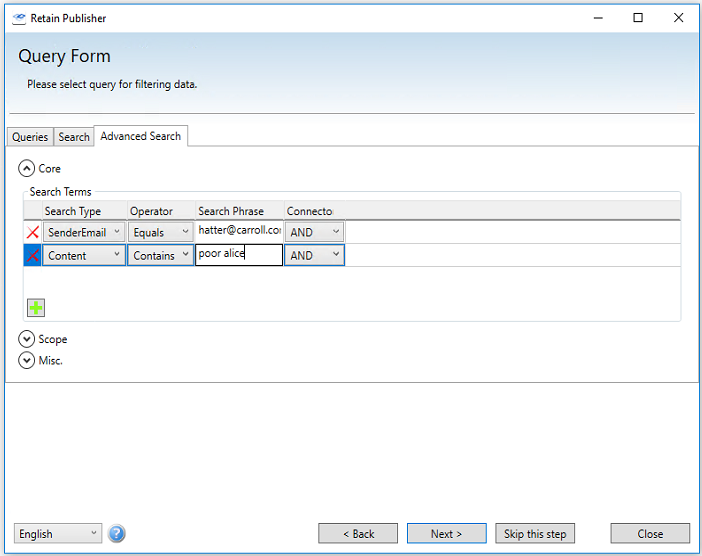
Core Panel
To add criteria to the Core query parameters, simply select the green ‘+’ icon, then select the different desired operator, search type, and phrase.
For instance, a very exclusive ‘contains’ search of the message contents will only publish messages that have the exact specified word or phrase in them. Fuzzy searches for approximates to the specified phrase, producing results including the words, but not in the specific order, or similar words.
Scope Panel
The Scope details what types of messages will be searched for. If no items are checked, all are allowed, and that setting is default.
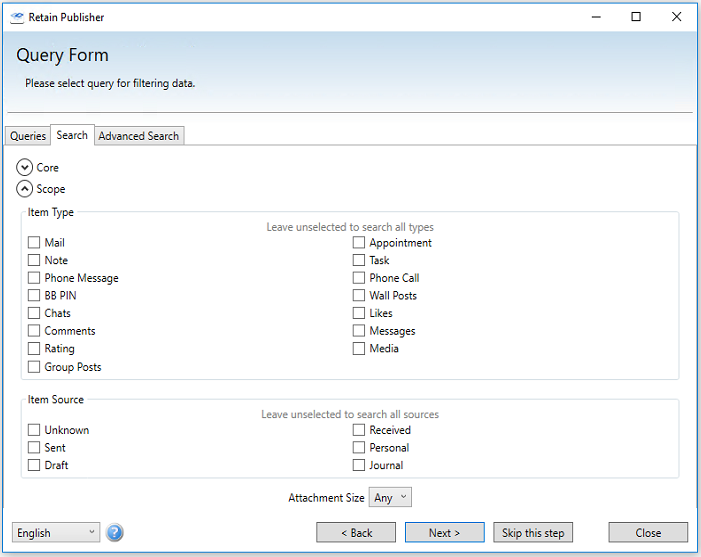
To restrict to specific messages and types, (some are mail system specific), at least one item must be selected. If one item is selected, or something is desired to be excluded from the published archive, select all desired item types. The Item Type, Item Source, and Attachment size, are all independent factors and must be specified independently or left blank. A blank item source and attachment size will not restrict those criteria when combined with a specified type.
Attachment sizes can be restricted or allowed into the message archive, and are accessible through the drop-down menu at the bottom of the query screen, under the ‘Attachment Size’ menu.
Less than 100 kilobytes
Greater than 100 kilobytes, but less than 1 megabyte
Greater than 1 megabyte, but less than 10 megabytes
Greater than 10 megabytes, but less than 100 megabytes
Greater than 100 megabytes
Misc Panel
The Miscellaneous panel allows you to restrict the message based on the message's status. Options are Doesn't matter, True or False.
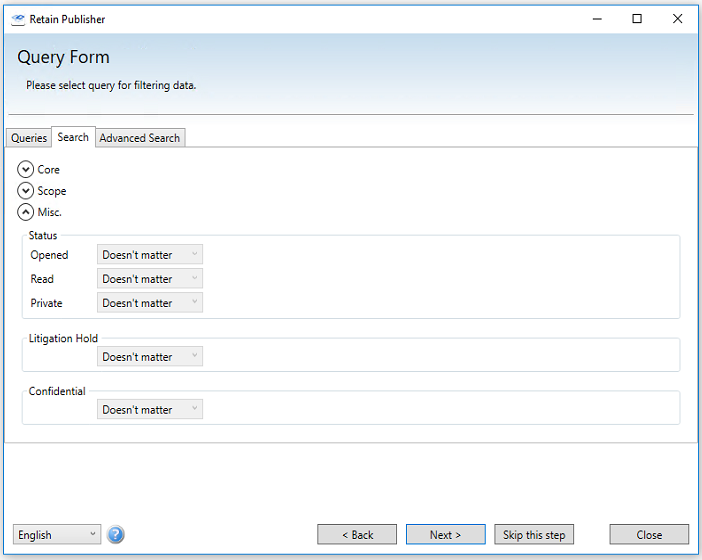
Select ‘Next’ to continue.
Folder Structure and Date Range Page
Choose how much of the folder structure and date range you wish to download. By default, the entire date range of the system will be searched.
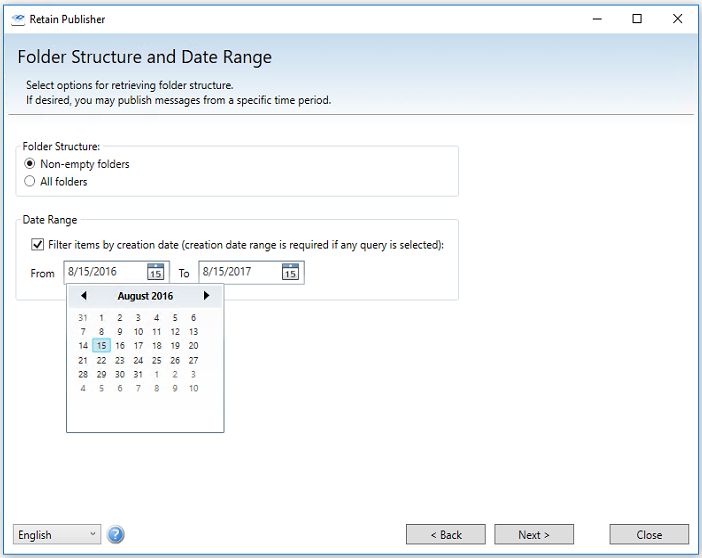
Simply selecting the desired setting will make it active in the search criteria. Set as desired and continue.
The publisher can also be restricted to exclude all empty folders from the published archive.
The Date Range allows for specific item date ranges to be selected or excluded. The query will cause the publisher to only look for the specific mail required within the specified time frame. The time range can have a start date, an end date, or both. This feature is disabled if a saved query is being used.
This setting differs from the following time restriction in that the start and end times may be specified in a range, instead of a specific hard date. Only messages strictly adhering to the range will be published. If a date range is desired, enable the date range and select the desired range.
A date range is required to be specified if the active query is anything other than a previously saved query, so make sure it is set to an acceptable window for the desired data. The publisher automatically defaults the date range to one year.
Click on the ‘From’ or ‘To‘ dates to reveal the data selection calendar and specify the date as desired.
Click ‘Next’ to continue.
Indexer Filter Settings Page
Select what types of documents to be indexed. It is best to index all types of documents so all items may be searched.
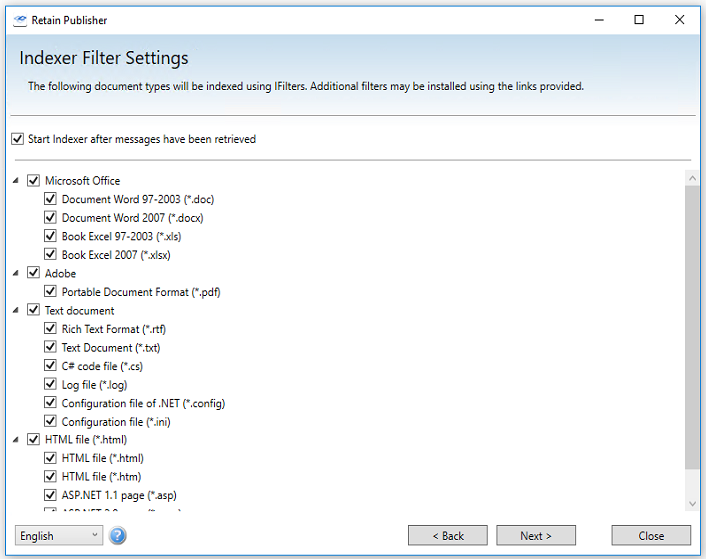
The Publisher can create and index the archive for faster searching and browsing by the Viewer. It is highly recommended to index a published archive. All default filters are shown. To enable Adobe PDF indexing you will need to install Adobe PDF iFilter found on Adobe’s web site.
Click ‘Next’ to continue.
The Publisher will connect to the Retain Server and export the qualifying messages from the selected users mailboxes and builds the local archive.
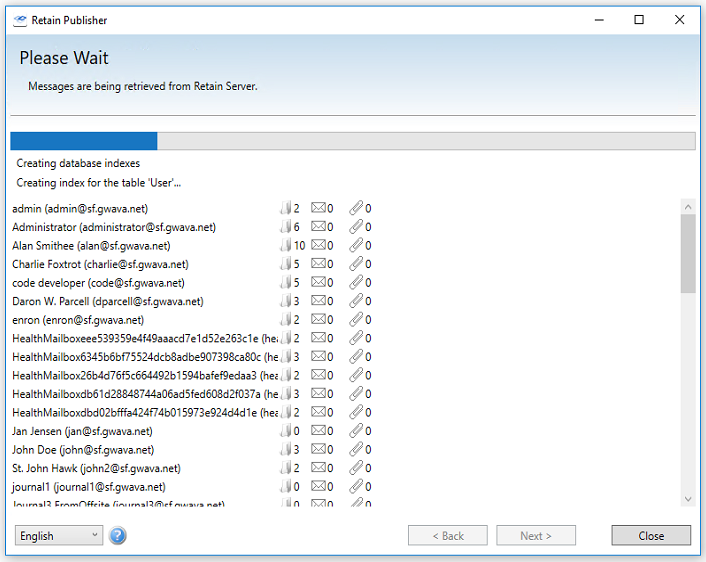
When the Publisher is done, it will display a report on the job. Depending on whether the exported archive was selected to be indexed after the job is done, the indexer will run. A.net error may occur at the end of Indexing, caused by an error in Adobe iFilter, if this error occurs, please install the latest Adobe PDF iFilter found on Adobe’s web site.
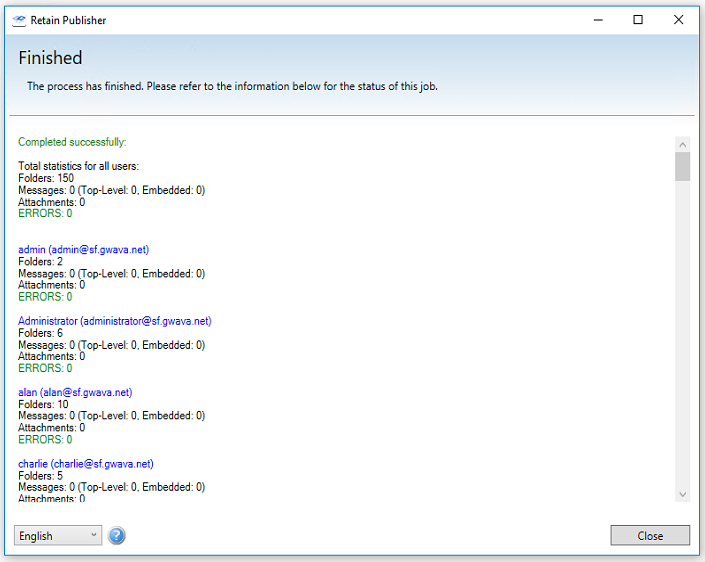
Select ‘Close’ to exit the publishing wizard and the indexer will automatically run if that option was selected. With a successful publishing job, the archive is now ready to be connected to the Viewer.
2.2.5 Retain Indexer
Retain Indexer runs automatically after Publisher completes the download. If the Indexer was not automatically run, it must be run before the Viewer can search the archive.
Select the archive and press "Start indexing"
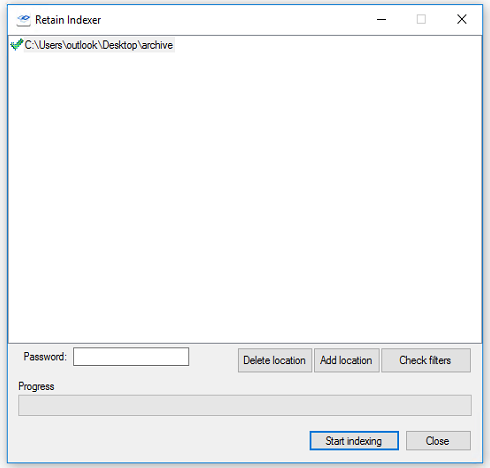
If an archive is password protected, you will need to provide the password before indexing can be run successfully.
Delete location will remove the archive from the display but not the disk.
Add location will allow you to add an archive location.
Check filters shows installed indexing filters and can be enabled or disabled.
2.2.6 Retain Viewer
To connect to the published archive, locate the shortcut to the installed Retain Viewer and start the Viewer.
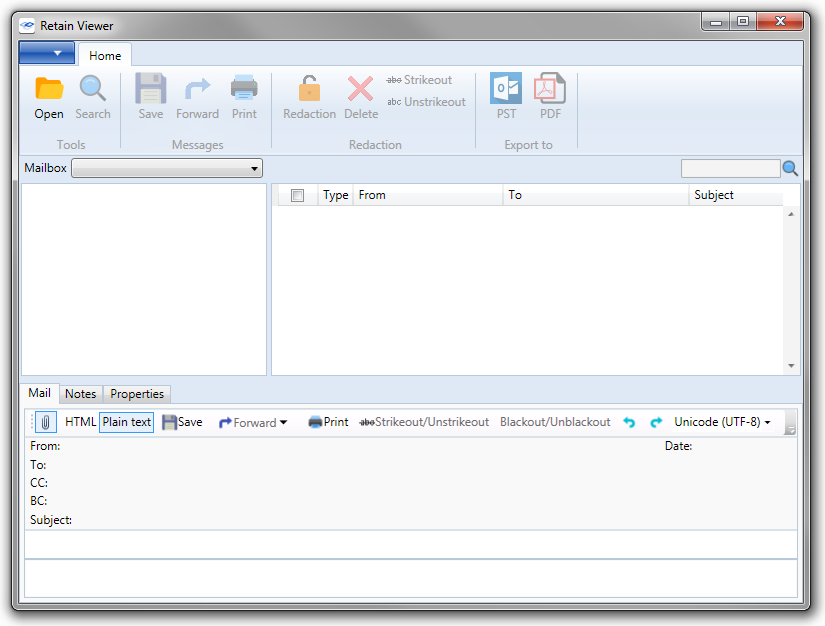
The viewer must be pointed to a valid database on initial startup. If the viewer does not prompt for the location to a published database, or if a new database is desired, select the ‘Open’ button and browse to and select the containing folder. If the Viewer has been previously opened, it will remember the last database opened.
The viewer is setup similar to an email client, with the mailbox and account on the left, the selected account’s contents fill the space on the top right, and any selected message’s contents are displayed along the bottom. Tabs allow access to the message properties or text, and highlighted buttons below the tabs determine what is shown and how, (Attachments, HTML, Plain Text). The Viewer also has the ability to forward the selected message out of the portable archive to any specified address.
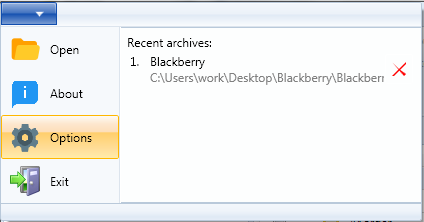
To access an archive, select the ‘open’ button from the top toolbar, or select the ‘Open’ option from the ‘File’ dropdown menu.
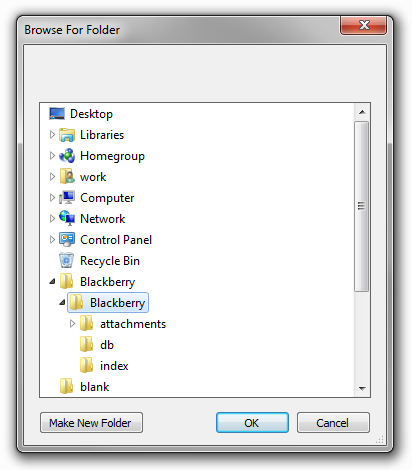
The Viewer only needs to know the base location of the archive, or the folder selected in the Publisher as the archive location. The ‘Open’ menu starts a browse window.
Browse to the location where the portable archive is located, select it, and click ‘OK’.
If the archive was password protected, the correct password must be entered before the Viewer can gain access.
Once the Archive has opened, all mailboxes contained in the archive are displayed. Select a mailbox to access the mail in the archive.
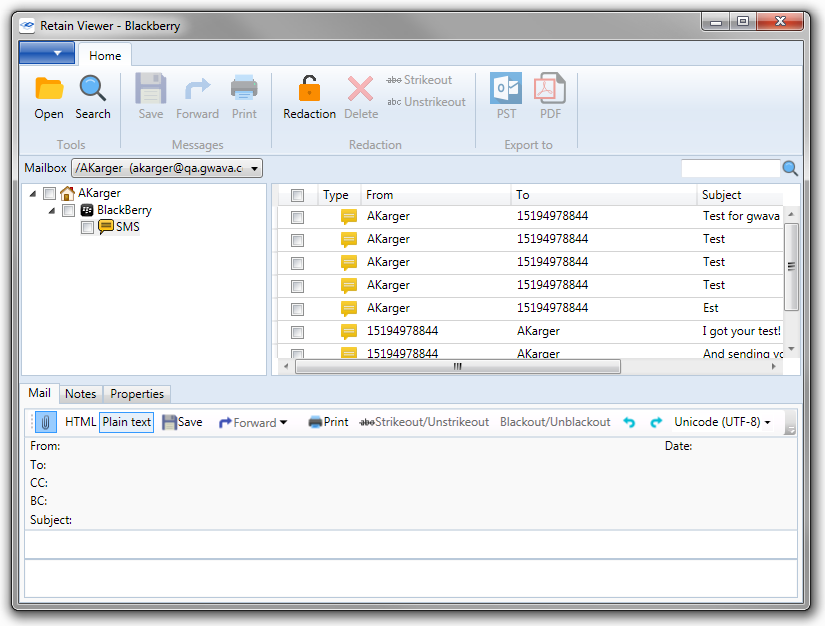
It is important to note that while the Publisher stores time in UTC, the time displayed in the viewer, located in the ‘Date’ column for each message, is relative to the viewer’s installed time zone, it is not in UTC. Messages published in PDF also display according local time zone. PST is exported in UTC, but Outlook rounds to the nearest minute, and displays the UTC time stamp in local time.
The text of the selected message will be displayed in the bottom viewer pane. The viewer contains options to show or hide the attachments, forward the message, as well as whether to view the message in plain text, or in HTML when available.

HTML: Select the HTML version of the item, if available.
Plain text: Select the text version of the item, if available.
Save: Save the current item to disk.
Forward: Forward the current item to an email address.
Print: Print the current item.
Strikeout/Unstrikeout: Toggle the strikeout feature of the current highlighted section.
Blackout/Unblackout: Toggle the blackout feature of the current highlighted section.
Undo redaction: A green reverse arrow that undos the last action.
Redo redaction: A green forward arrow that redos the last action.
Encoding drop down menu: Change the item encoding, depending on the encoding schemes installed to the OS. Default, Unicode (UTF-8).
Attachments are shown along the bottom of the message window. Double-clicking on an attachment will send it to the operating system to open in the appropriate program.
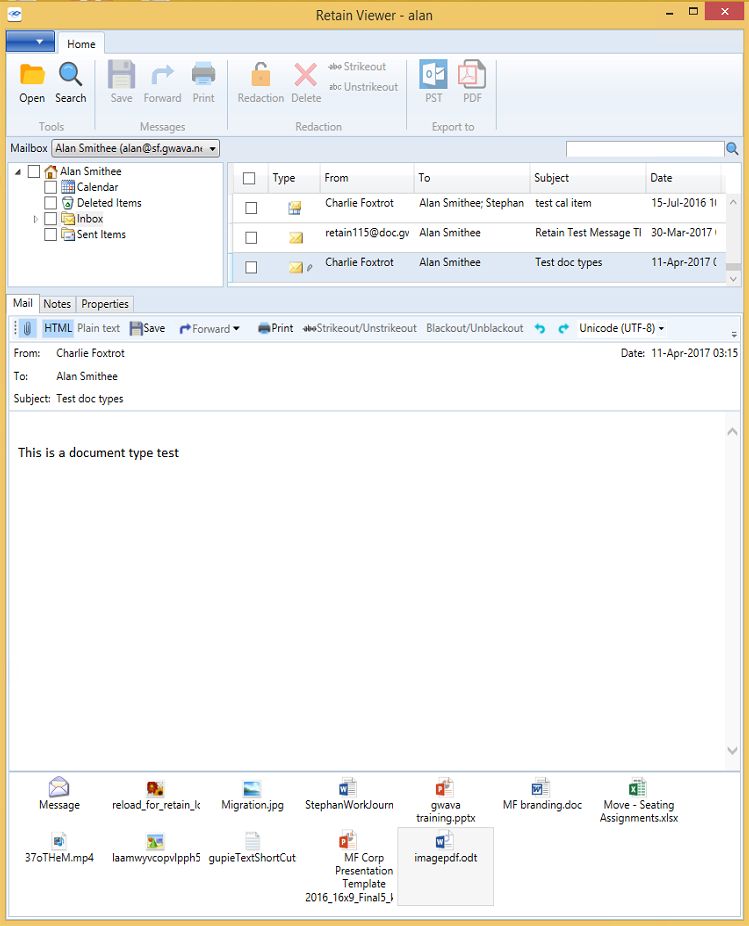
The properties tab displays the essential information on the mail item in question. The created, delivered, read status, and store date are displayed along with the identification number, message source, etc.

2.2.7 Forward
The Forward, and forward as attachment options, (found both on the main toolbar, as well as a drop down menu in the toolbar in the view window), allow the Retain Viewer to send the selected message from the archive to a destination account. ‘Forward’ functions exactly as the forward function in an email client. The ‘Forward as attachment’ creates an attachment from the selected email and attaches it to a message sent.

In order to utilize the ‘Forward’ option in the viewer pane, the Viewer must be configured with a mail server. To tell the Viewer which SMTP server and account to use to send messages, select ‘Options’ from the drop-down menu.
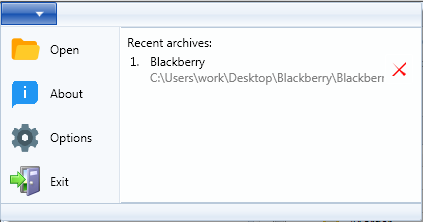
2.2.8 Settings
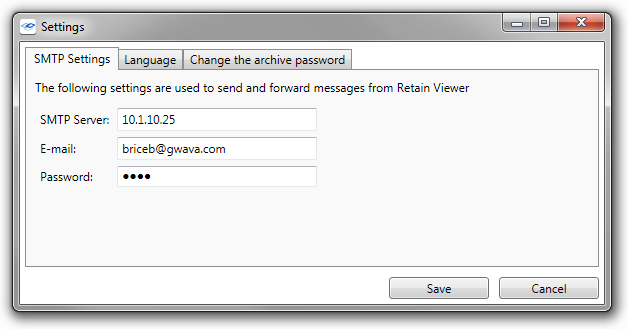
The ‘Settings’ configuration menu will appear. Enter the DNS or address of the SMTP Server desired to use for the Viewer system, and an appropriate account, (Username is required, password is optional), to connect and send messages.
Language and displayed document format settings may be changed as well for the specific viewer.
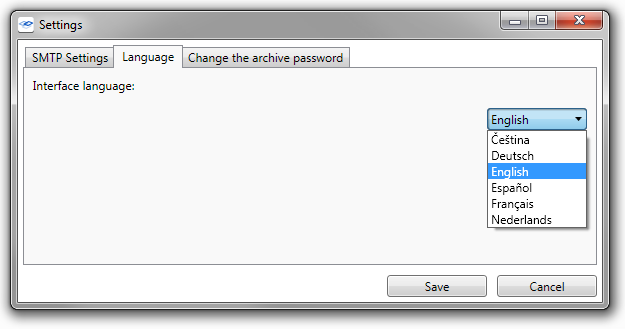
The ‘Change the archive password’ tab allows access to modify the password of the current archive. In order to change a password on an archive, the original password must be supplied first. If there is no password on an archive, a new password may be created; simply leave the current password field blank and input the desired password in the provided fields. While passwords may be changed, or created, the requirement for a password may not be removed.
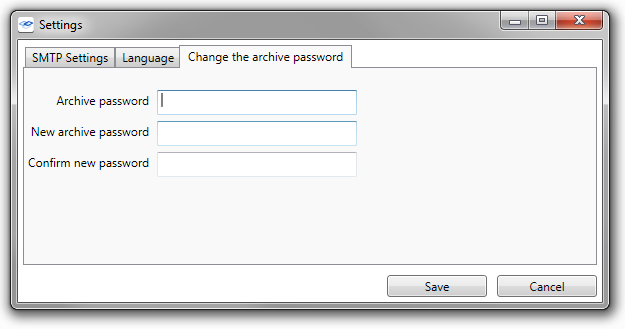
2.2.9 Redaction
Redaction allows the viewing auditor to compile notes on the archive.
NOTE:Attachments cannot be redacted directly because they require third-party software to open. However, the archive can be exported as PDF and a third-party plugin can be used to redact the PDF portfolio.

The notes are appended to the entire archive, and not any individual messages, which makes Redaction extremely useful to compile messages and identify messages of interest.
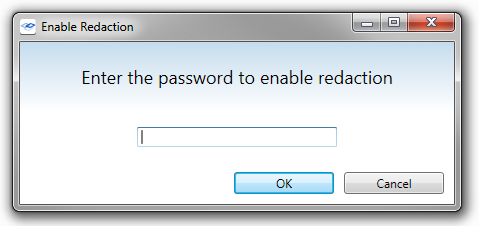
To enable redaction, the archive must first be exported with the redaction option enabled in the publisher, (if the archive was not published with Redaction enabled, the option will appear grayed out), and a redaction password must be entered.
On a redaction-enabled archive, to access the feature, it must be ‘enabled’ in the viewer. This option is found on the toolbar. Select ‘Redaction’ and enter the redaction password.
When Redaction is enabled, the ‘Strikeout/Unstrikeout’, ‘Black out’ options, and ‘Notes’ tab become active. The Notes tab works much like a notepad that is always connected to the archive. Items of interest or whole messages’ texts can be copied and compiled in the redaction notes. Messages with notes on them are marked in the archive viewer with a notepad icon in the message list.
Redaction notes are attached to the message. Notes are only accessible for the messages which have notes, indicated by the note icon.
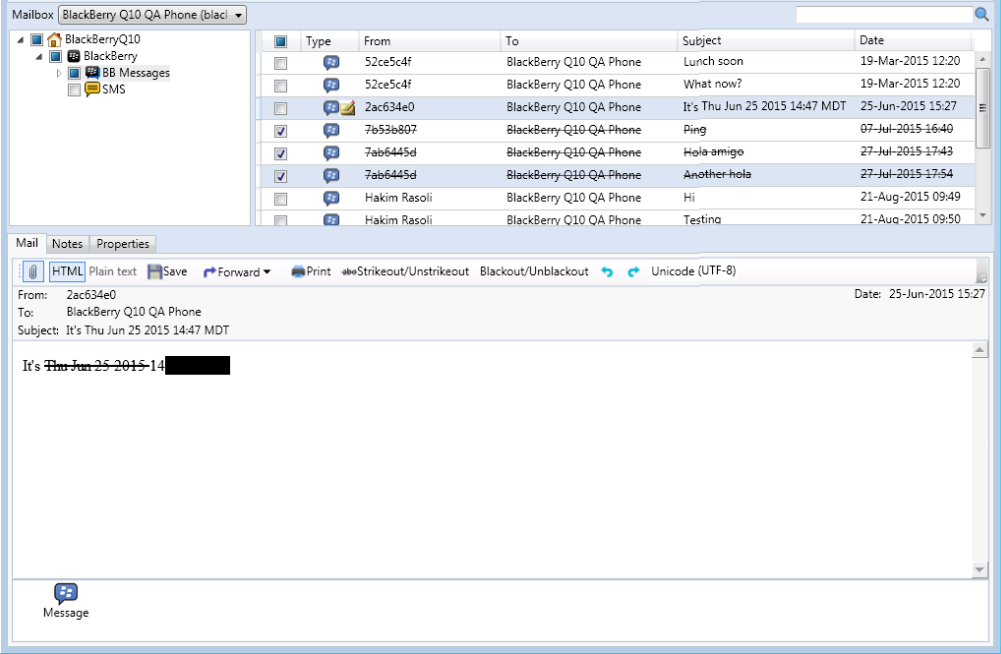
2.2.10 Strikeout/Unstrikeout and Blackout
The Strikeout option enables a review of the archive before handing it over to legal scrutiny. This allows the user to denote items and messages which do not apply, or are unnecessary for the published goal. For example, if an investigation is being performed on specific activity, or internally on the account and all correspondence with a customer, the strikeout will allows messages or even sections of messages which do not apply, to be marked out.
To use the Strikeout, first Redaction must be enabled. After redaction is enabled, the options become active. To Strikeout or Unstrikeout messages in the message list, select the messages by placing a check in the checkbox and then select the ‘Strikeout’, or ‘Unstrikeout’ button from the top bar. To strikeout sections in the body of the message, highlight the desired section and select the ‘Strikeout/Unstrikeout’ button from the view message bar.
The Blackout option allows a reviewer to remove sensitive information, such as social security numbers, from published messages. To use the Blackout option, highlight the desired text and select the ‘Blackout’ button. Blackout cannot be removed from text.
2.2.11 Searching the Archive
The Retain Viewer provides full search functionality.

The search function is accessed through either the shortcut ‘Ctrl+F’ or by selecting ‘Search’ from the toolbar.
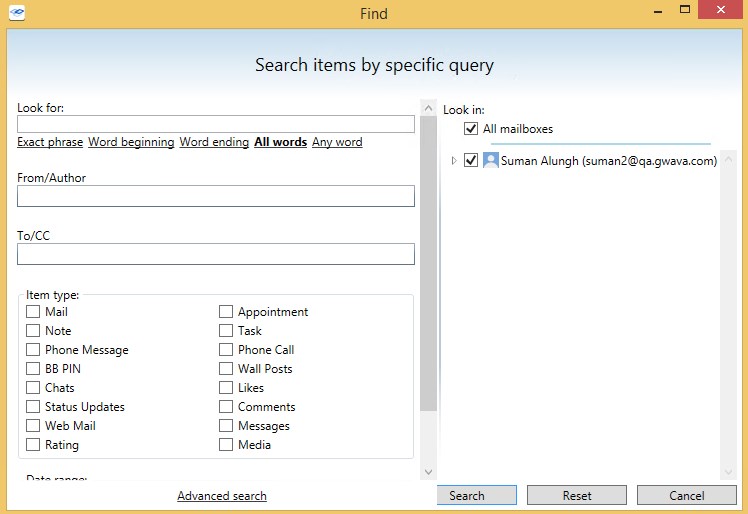
The different options for the search are shown with the criteria input below the options. Any text string or value can be searched for in the full text of the mail, or simply in the subject line. The following options are functional for both the search messages option included here, as well as the publisher search criteria. In the search ‘look for’ line:
-
&& represents ‘and’
-
|| represents ‘or’
-
No operators work as an exact match search.
-
For example:
-
Boy girl = exact search for “Boy girl”
-
Boy && girl = Boy and girl search
-
Boy || Girl = Boy OR girl search
-
Boy && girl || dog && cat = Boy and girl OR dog and cat search.
NOTE:These search operators DO NOT work with the search option ‘starts with’, but can be utilized with all of the other base modes of the search.
The search engine does not recognize the following English ‘stop words’ or articles of speech:
a, an, and, are, as, at, be, but, by, for, if, in, into, is, it, no, not, of, on, or, such, that, the, their, then, there, these, they, this, to, was, will, with

These words are not indexed, and thus are not taken into account if they appear in the list of words specified for the search. This may result in some unanticipated results in “exact” searches.
In addition to the operators and text, the sending Author or the destination and carbon copy recipients of a message as well as item type and the date range can specify or restrict a search. Selection of the date range is done through an interactive calendar.
Be sure to select the desired mailbox or mailboxes to apply the search through. (The depicted example archive only contains one mailbox.) Select ‘Search’ to begin.
When the search is finished, the results will be displayed in a separate results window, identical to the main viewer interface.
2.2.12 PDF and PST Export
Retain Viewer can export selected files and messages from a mailbox or archive to a PDF or PST archive file.
PST
Prerequisites:
-
Outlook
PST export requires Outlook, or the associated plugin. The viewer will prompt for plugin installation if necessary. It is highly recommended to have Outlook installed.
To migrate to PST, select desired files in the view window then select ‘PST’ from the toolbar.

A window confirming the location and file will open. When the ‘Save’ button is selected the PST file is created and available for use.
Prerequisites:
-
Adobe Acrobat or Adobe Acrobat Reader
-
Adobe Flash
The export PDF is a PDF Portfolio and requires Adobe Flash to be installed on the workstation to properly display the message selector header. Adobe Acrobat Reader DC appears to have Flash integrated and does not need a separate install.
The Retain Viewer can also save selected messages as PDF. Select the desired messages and click ‘PDF’ in the toolbar.

The selected messages are then published in a single PDF. This is an Adobe PDF Portfolio, this requires Adobe Flash to be installed on the workstation for full functionality, or you will only see the title page.
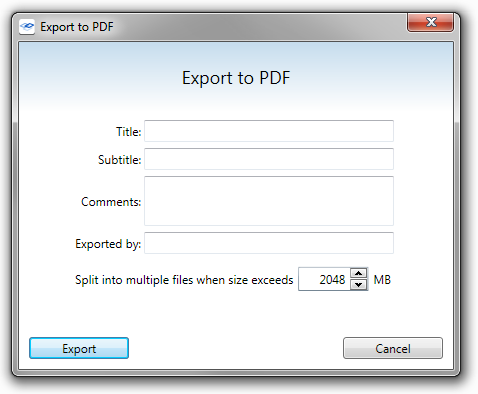
In addition to the standard file name and location, the PDF has title, exported by, and comment sections that the user is prompted to specify before the viewer publishes the PDF.
The finished PDF contains all the information displayed in the viewer, as well as an option to save individual text or message sources. (This information includes redactions, litigation tags, confidential tags, strikeouts etc. from the Retain Server archive as well as the Viewer.)
The published PDF displays the separate emails along the top in a list and displays the message information in a lower pane, as shown below. Flash must be installed on the workstation viewing the PDF Portfolio file.
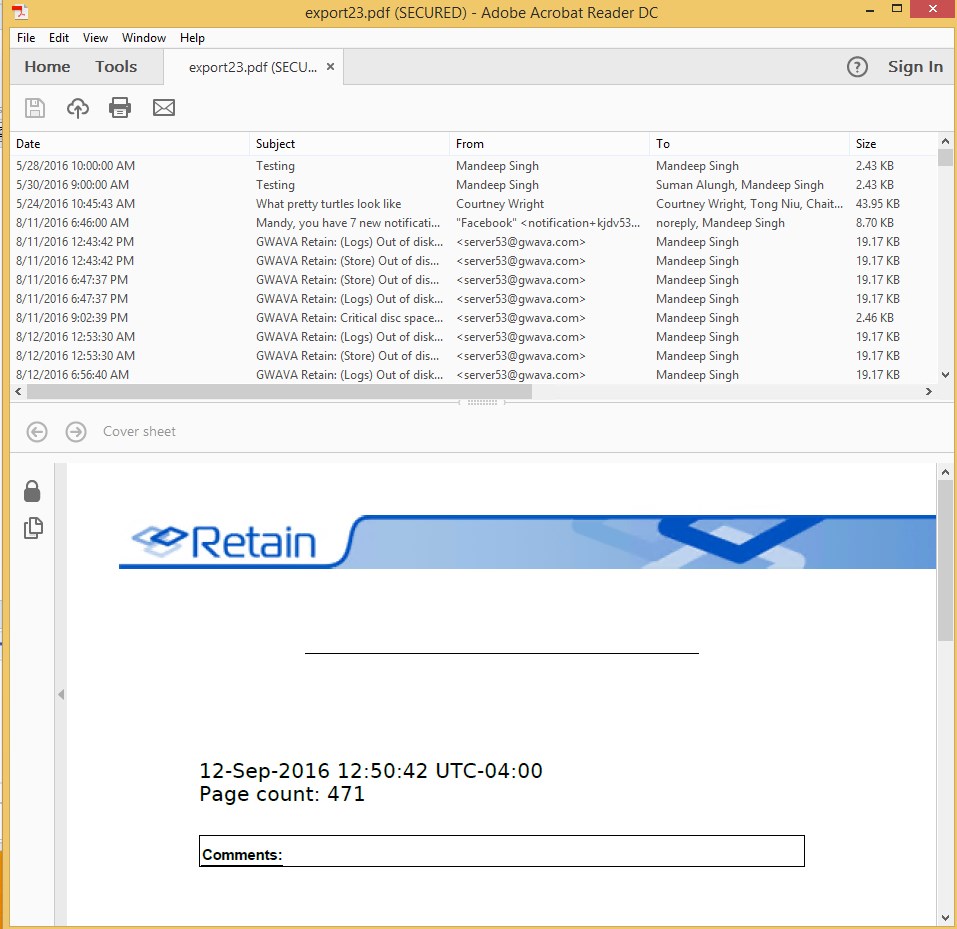
2.2.13 Enabling Debug Logging
On occasion, extra logging will be needed for troubleshooting purposes.
The Publisher and Viewer logs are found in the %APPDATA%/Gwava/Retain Publisher folder
To enable debug level logging:
-
Close Publisher, if open
-
Open File Explorer and enter %APPDATA% in the address bar
-
Enter the Gwava folder
-
Enter the Retain Publisher folder
-
Edit Publisher.settings.xml
-
Find the line <LogLevel>INFO,WARN,ERROR,FATAL</LogLevel>
-
Add the DEBUG level <LogLevel>INFO,WARN,ERROR,FATAL,DEBUG</LogLevel>

-
Save and exit
-
Run Publisher